[English] 日本語
 Yorodumi
Yorodumi- PDB-7k4f: Cryo-EM structure of human TRPV6 in complex with (4- phenylcycloh... -
+ Open data
Open data
- Basic information
Basic information
| Entry | Database: PDB / ID: 7k4f | |||||||||||||||||||||
|---|---|---|---|---|---|---|---|---|---|---|---|---|---|---|---|---|---|---|---|---|---|---|
| Title | Cryo-EM structure of human TRPV6 in complex with (4- phenylcyclohexyl)piperazine inhibitor 31 | |||||||||||||||||||||
 Components Components | Transient receptor potential cation channel subfamily V member 6 | |||||||||||||||||||||
 Keywords Keywords |  MEMBRANE PROTEIN/INHIBITOR / MEMBRANE PROTEIN/INHIBITOR /  TRPV6 / TRPV6 /  ion channel / ion channel /  inhibitor / inhibitor /  MEMBRANE PROTEIN / MEMBRANE PROTEIN /  MEMBRANE PROTEIN-INHIBITOR complex MEMBRANE PROTEIN-INHIBITOR complex | |||||||||||||||||||||
| Function / homology |  Function and homology information Function and homology informationparathyroid hormone secretion / regulation of calcium ion-dependent exocytosis /  TRP channels / calcium ion import across plasma membrane / calcium ion homeostasis / TRP channels / calcium ion import across plasma membrane / calcium ion homeostasis /  calcium channel complex / calcium ion transmembrane transport / calcium channel complex / calcium ion transmembrane transport /  calcium channel activity / response to calcium ion / calcium ion transport ...parathyroid hormone secretion / regulation of calcium ion-dependent exocytosis / calcium channel activity / response to calcium ion / calcium ion transport ...parathyroid hormone secretion / regulation of calcium ion-dependent exocytosis /  TRP channels / calcium ion import across plasma membrane / calcium ion homeostasis / TRP channels / calcium ion import across plasma membrane / calcium ion homeostasis /  calcium channel complex / calcium ion transmembrane transport / calcium channel complex / calcium ion transmembrane transport /  calcium channel activity / response to calcium ion / calcium ion transport / calcium channel activity / response to calcium ion / calcium ion transport /  calmodulin binding / identical protein binding / calmodulin binding / identical protein binding /  metal ion binding / metal ion binding /  plasma membrane plasma membraneSimilarity search - Function | |||||||||||||||||||||
| Biological species |   Homo sapiens (human) Homo sapiens (human) | |||||||||||||||||||||
| Method |  ELECTRON MICROSCOPY / ELECTRON MICROSCOPY /  single particle reconstruction / single particle reconstruction /  cryo EM / Resolution: 3.75 Å cryo EM / Resolution: 3.75 Å | |||||||||||||||||||||
 Authors Authors | Neuberger, A. / Nadezhdin, K.D. / Singh, A.K. / Sobolevsky, A.I. | |||||||||||||||||||||
| Funding support |  United States, 6items United States, 6items
| |||||||||||||||||||||
 Citation Citation |  Journal: Sci Adv / Year: 2020 Journal: Sci Adv / Year: 2020Title: Inactivation-mimicking block of the epithelial calcium channel TRPV6. Authors: Rajesh Bhardwaj / Sonja Lindinger / Arthur Neuberger / Kirill D Nadezhdin / Appu K Singh / Micael R Cunha / Isabella Derler / Gergely Gyimesi / Jean-Louis Reymond / Matthias A Hediger / ...Authors: Rajesh Bhardwaj / Sonja Lindinger / Arthur Neuberger / Kirill D Nadezhdin / Appu K Singh / Micael R Cunha / Isabella Derler / Gergely Gyimesi / Jean-Louis Reymond / Matthias A Hediger / Christoph Romanin / Alexander I Sobolevsky /     Abstract: Epithelial calcium channel TRPV6 plays vital roles in calcium homeostasis, and its dysregulation is implicated in multifactorial diseases, including cancers. Here, we study the molecular mechanism of ...Epithelial calcium channel TRPV6 plays vital roles in calcium homeostasis, and its dysregulation is implicated in multifactorial diseases, including cancers. Here, we study the molecular mechanism of selective nanomolar-affinity TRPV6 inhibition by (4-phenylcyclohexyl)piperazine derivatives (PCHPDs). We use x-ray crystallography and cryo-electron microscopy to solve the inhibitor-bound structures of TRPV6 and identify two types of inhibitor binding sites in the transmembrane region: (i) modulatory sites between the S1-S4 and pore domains normally occupied by lipids and (ii) the main site in the ion channel pore. Our structural data combined with mutagenesis, functional and computational approaches suggest that PCHPDs plug the open pore of TRPV6 and convert the channel into a nonconducting state, mimicking the action of calmodulin, which causes inactivation of TRPV6 channels under physiological conditions. This mechanism of inhibition explains the high selectivity and potency of PCHPDs and opens up unexplored avenues for the design of future-generation biomimetic drugs. | |||||||||||||||||||||
| History |
|
- Structure visualization
Structure visualization
| Movie |
 Movie viewer Movie viewer |
|---|---|
| Structure viewer | Molecule:  Molmil Molmil Jmol/JSmol Jmol/JSmol |
- Downloads & links
Downloads & links
- Download
Download
| PDBx/mmCIF format |  7k4f.cif.gz 7k4f.cif.gz | 433.3 KB | Display |  PDBx/mmCIF format PDBx/mmCIF format |
|---|---|---|---|---|
| PDB format |  pdb7k4f.ent.gz pdb7k4f.ent.gz | 358.3 KB | Display |  PDB format PDB format |
| PDBx/mmJSON format |  7k4f.json.gz 7k4f.json.gz | Tree view |  PDBx/mmJSON format PDBx/mmJSON format | |
| Others |  Other downloads Other downloads |
-Validation report
| Arichive directory |  https://data.pdbj.org/pub/pdb/validation_reports/k4/7k4f https://data.pdbj.org/pub/pdb/validation_reports/k4/7k4f ftp://data.pdbj.org/pub/pdb/validation_reports/k4/7k4f ftp://data.pdbj.org/pub/pdb/validation_reports/k4/7k4f | HTTPS FTP |
|---|
-Related structure data
| Related structure data |  22667MC 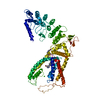 7d2kC  7k4aC  7k4bC  7k4cC  7k4dC  7k4eC C: citing same article ( M: map data used to model this data |
|---|---|
| Similar structure data |
- Links
Links
- Assembly
Assembly
| Deposited unit | 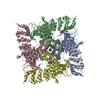
|
|---|---|
| 1 |
|
- Components
Components
| #1: Protein | Mass: 77021.805 Da / Num. of mol.: 4 Source method: isolated from a genetically manipulated source Source: (gene. exp.)   Homo sapiens (human) / Gene: TRPV6, ECAC2 / Production host: Homo sapiens (human) / Gene: TRPV6, ECAC2 / Production host:   Homo sapiens (human) / References: UniProt: Q9H1D0 Homo sapiens (human) / References: UniProt: Q9H1D0#2: Chemical | ChemComp-5GK / #3: Chemical | ChemComp-CA / | Has ligand of interest | Y | |
|---|
-Experimental details
-Experiment
| Experiment | Method:  ELECTRON MICROSCOPY ELECTRON MICROSCOPY |
|---|---|
| EM experiment | Aggregation state: PARTICLE / 3D reconstruction method:  single particle reconstruction single particle reconstruction |
- Sample preparation
Sample preparation
| Component | Name: sample 1 / Type: COMPLEX / Entity ID: #1 / Source: RECOMBINANT | ||||||||||||||||||||||||||||||
|---|---|---|---|---|---|---|---|---|---|---|---|---|---|---|---|---|---|---|---|---|---|---|---|---|---|---|---|---|---|---|---|
| Molecular weight | Experimental value: NO | ||||||||||||||||||||||||||||||
| Source (natural) | Organism:   Homo sapiens (human) Homo sapiens (human) | ||||||||||||||||||||||||||||||
| Source (recombinant) | Organism:   Homo sapiens (human) Homo sapiens (human) | ||||||||||||||||||||||||||||||
| Buffer solution | pH: 8 | ||||||||||||||||||||||||||||||
| Buffer component |
| ||||||||||||||||||||||||||||||
| Specimen | Conc.: 3 mg/ml / Embedding applied: NO / Shadowing applied: NO / Staining applied : NO / Vitrification applied : NO / Vitrification applied : YES : YES | ||||||||||||||||||||||||||||||
| Specimen support | Grid material: GOLD / Grid mesh size: 200 divisions/in. / Grid type: C-flat-1.2/1.3 | ||||||||||||||||||||||||||||||
Vitrification | Instrument: FEI VITROBOT MARK IV / Cryogen name: ETHANE / Humidity: 100 % / Chamber temperature: 277 K |
- Electron microscopy imaging
Electron microscopy imaging
| Experimental equipment |  Model: Titan Krios / Image courtesy: FEI Company |
|---|---|
| Microscopy | Model: TFS KRIOS |
| Electron gun | Electron source : :  FIELD EMISSION GUN / Accelerating voltage: 300 kV / Illumination mode: FLOOD BEAM FIELD EMISSION GUN / Accelerating voltage: 300 kV / Illumination mode: FLOOD BEAM |
| Electron lens | Mode: BRIGHT FIELD Bright-field microscopy Bright-field microscopy |
| Image recording | Average exposure time: 2.5 sec. / Electron dose: 58 e/Å2 / Film or detector model: GATAN K3 (6k x 4k) / Num. of grids imaged: 1 / Num. of real images: 6270 |
| Image scans | Width: 5760 / Height: 4092 |
- Processing
Processing
| Software | Name: PHENIX / Version: 1.11.1_2575: / Classification: refinement | ||||||||||||||||||||||||
|---|---|---|---|---|---|---|---|---|---|---|---|---|---|---|---|---|---|---|---|---|---|---|---|---|---|
| EM software |
| ||||||||||||||||||||||||
CTF correction | Type: NONE | ||||||||||||||||||||||||
| Particle selection | Num. of particles selected: 829881 | ||||||||||||||||||||||||
3D reconstruction | Resolution: 3.75 Å / Resolution method: FSC 0.143 CUT-OFF / Num. of particles: 137828 / Symmetry type: POINT | ||||||||||||||||||||||||
| Refine LS restraints |
|
 Movie
Movie Controller
Controller







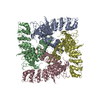
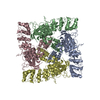
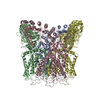
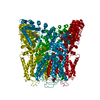


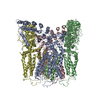
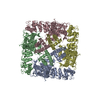
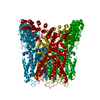
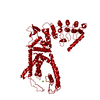
 PDBj
PDBj





